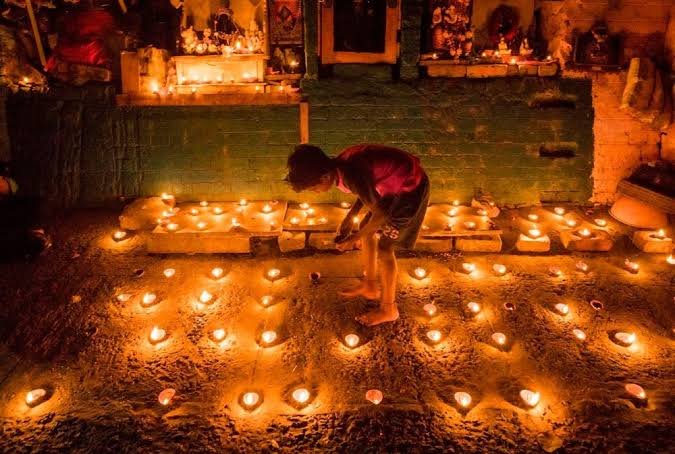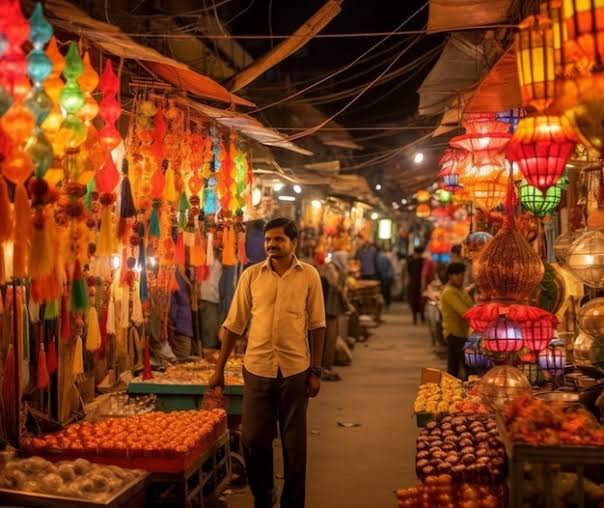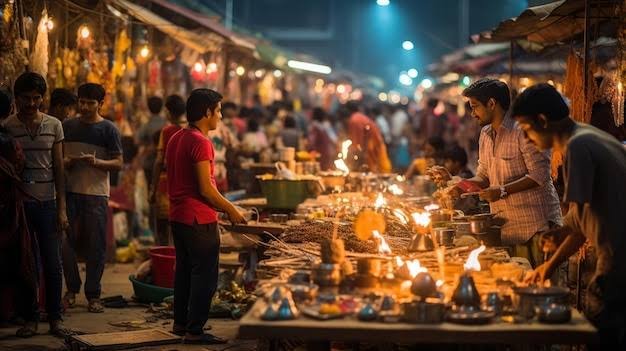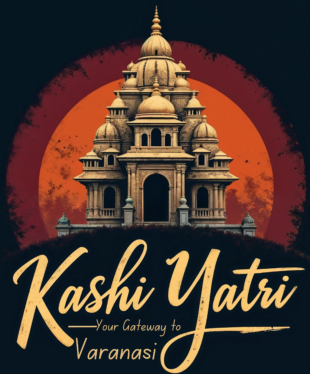Diwali brings a distinct bloom to Varanasi’s flower marketplaces, with millions of garlands sold in days, adding color, culture, and economic vibrancy to the city’s festive season.
In the culturally rich city of Varanasi, Dhanteras and Diwali bring an unusual rush to local markets. As people prepare for the festival of lights, there is an incredible demand for flowers and garlands, typically used for decorating and religious events. This year, the flower markets in Varanasi experienced an amazing surge, with sales topping ₹8-10 crore in just a few days. Over 1.5 million garlands were sold, and significant market places including Bansphatak and Englishiyaline were buzzing with crowds, both local and from outlying areas. This spike not only displays the city’s passion for Diwali but also highlights the economic significance of this vibrant event.
Varanasi’s Unique Festive Bloom
Diwali in Varanasi is not just about lights and decorations; it’s also about rituals deeply steeped in flora. Marigold and rose garlands are very popular during this season. Whether they’re hanging at doorways or placed in temples, flowers are fundamental to Diwali celebrations, symbolizing prosperity and purity. Farmers and traders transport these blossoms from adjacent villages, turning Varanasi’s flower markets into an unmistakable show.

This year’s festive season witnessed record-breaking sales in the city’s flower markets. Over 1.5 million garlands were sold in only three days, with sellers working round-the-clock to accommodate the demand. Such strong sales highlight the importance of these festive occasions for local farmers and sellers, as they see a surge in income during these days, earning a substantial share of their annual profits.
Flower Markets Transformed
During the Diwali season, flower markets in Varanasi such as Bansphatak and Englishiyaline evolve into busy hives of activity. Thousands of people jam these markets, with each stall festooned in garlands stacked several feet high. The range of flowers—ranging from yellow marigolds to brilliant crimson roses—offers shoppers a colorful display to pick from. Temporary stalls line the streets and sidewalks near these big flower marketplaces, contributing to the celebratory frenzy. In fact, the rush often leads to traffic jams as locals and tourists alike stop to admire and purchase floral decorations.

Despite the high demand, sellers managed to maintain their stalls well-stocked. Farmers and traders from outlying villages arrived early each morning with fresh flowers to restock the market stands. The city’s enthusiasm for flower purchasing during Diwali keeps these sellers working continually throughout the festival days, with many even selling through the night to suit consumers.
Top Flowers in Demand and Prices
The Diwali season calls for special flowers that bear traditional meaning. The flowers most in demand this year were marigolds, roses, and lotus blooms. Each of these flowers serves a distinct role during Diwali:
- Marigolds: Marigold garlands are vital in every home and temple during Diwali. Their vivid orange and yellow colors indicate prosperity, and they are frequently used to decorate doors and altars. Marigold garlands offered at rates ranging from ₹100 to ₹150 for tiny parts, with longer, more intricate garlands costing up to ₹350 each.
- Roses: Roses are popular for their scent and beauty. They are widely used in worship, symbolizing love and dedication. Single rose blossoms sold for roughly ₹5, while garlands of roses cost between ₹100 and ₹200, depending on their size and intricacy.
- Lotus Flowers: Lotus flowers retain a unique position in Indian religious traditions and are considered sacred. Each lotus flower went for ₹50-₹60, and they were much sought after for temple decorations and sacrifices.
In addition to this, ashoka leaves and jasmine were also in high demand. Small bundles of ashoka leaves were purchased at roughly ₹20, and jasmine was used for constructing garlands and ornamental items. Due of the tremendous demand, prices for these flowers were higher than usual, making this season extremely profitable for vendors.
Around-the-Clock Sales and Increased Rates
This Diwali, the flower stalls in Varanasi saw an unparalleled level of activity. Vendors claimed virtually 24-hour operations to accommodate the flood of buyers. The demand was so great that even loose flowers, which are normally given away with garlands, sold at a premium rate of ₹200 per kilogram. The heightened demand and the around-the-clock sales reflect the essential role flowers play in Diwali celebrations for locals and tourists alike.

The streets near these marketplaces were packed with temporary flower stalls, especially around prominent areas like Maldahiya Chowk. Even regions beyond these big flower markets, such Godowlia and Lahurabir, noticed a spike in flower prices due to the high demand and lively client base.
Farmers and Vendors: The Backbone of the Diwali Economy
The Diwali flower explosion is not just a boon for the markets but also a critical money source for local farmers and traders. Many farmers from nearby areas bring in their flowers every morning, ready to sell to the people in Varanasi. These farmers rely on festival seasons like Diwali for a substantial percentage of their income, and this short period of strong demand allows them to make significantly more than they would on typical days.
During Diwali, sellers and farmers labor in shifts to keep up with the demand, ensuring that the stalls remain stocked throughout the day. The revenue they receive during this time typically supports their families for the entire year. For many vendors, the Diwali season is an opportunity to generate big profits and enhance their financial foundation.
Dairy Products and the Festive Demand Surge

Diwali doesn’t just enhance flower sales; it also brings a considerable spike in demand for milk, paneer (cottage cheese), and other dairy products. People stock up on these things for the traditional sweets and foods they prepare for the festivities. Milk prices soared as high as ₹80 per liter, while paneer, necessary for many Diwali dishes, sold for between ₹360 and ₹400 per kilogram. Popular dairy stalls in locations like Bhojubir and Pandeypur experienced a similar rush, with lines of people anxious to buy essentials.
Local dairy producers experience a large bump in sales, much like the flower dealers, making Diwali a prosperous season across several sectors in Varanasi.
Diwali’s Decorative Tradition: The Yam (Suran)
Apart from flowers, Diwali in Varanasi contains a unique tradition of adorning and selling yams, locally known as suran. This root vegetable is a mainstay in festive dinners, symbolizing prosperity and longevity. Vendors adorn yams nicely, and they are presented prominently at vegetable stands to entice shoppers. This year, markets in locations like Dashashwamedh, Lahurabir, and Chetganj saw a considerable demand for suran, with consumers lined up to purchase this seasonal specialty.
Light Displays and Festive Fireworks
When evening falls on Diwali night, Varanasi transforms into a city of lights. Homes, temples, and market streets are decked with colorful LED lights and ornaments. Fireworks fill the night sky, casting reflections on the Ganges River and creating a stunning scene for the hundreds who gather along the ghats. These illuminations give the city a wonderful ambiance, luring tourists to renowned sites like the Dashashwamedh Ghat to view the fireworks display.

The illumination is not simply confined to residences; even shops and market stalls are decorated with lights, contributing to the joyful air. For locals and tourists alike, the experience of Diwali night in Varanasi is one of visual delight and cultural richness.
The Social and Economic Impact of Diwali on Varanasi
The economic benefits of Diwali in Varanasi extend far beyond the flower stalls. From vendors and farmers to local enterprises and small-scale craftspeople, the festive season generates cash for many people. The high demand for flowers, dairy products, and decorative things like suran offers vendors with an opportunity to optimize their revenue.
For many local businesses, Diwali represents one of the most lucrative seasons of the year. The flower shops alone contribute millions of rupees to the economy, illustrating how traditional celebrations drive economic activity in towns like Varanasi. Additionally, the event attracts tourists, who in turn spend on hotels, local food, and souvenirs, further strengthening the city’s economy.
Cultural Traditions and Unique Practices
Varanasi’s Diwali celebrations are defined by traditions that are unique to the city:
- purchasing at Crowded marketplaces: Varanasi’s citizens take pride in purchasing from local marketplaces around Diwali. Crowds assemble not only in flower marketplaces but also in stalls offering oil lamps, sweets, and other festive supplies.
- Suran Buying: The tradition of buying and adorning suran (yam) is particular to Varanasi. Families believe it brings good luck, and it has become a festive staple over the years.
- Fireworks and Lighting Displays: The ghats of Varanasi along the Ganges River create a stunning sight on Diwali night, with a mix of fireworks and lights reflecting on the river.
- Family Gatherings: Many families retain the tradition of meeting together, sometimes even playing games like cards, which are considered auspicious on Diwali night.
Conclusion: The Blooming Business and Festive Spirit of Diwali in Varanasi
Diwali in Varanasi is a great example of how cultural traditions merge with commercial activities to create a vibrant and thriving atmosphere. The city’s flower stalls, illuminated avenues, and crowded markets showcase the combination of faith and commerce that marks this joyful season. The demand for flowers and other essentials offers a major economic boost to Varanasi, allowing traders and farmers to make a big profit.

Beyond the numbers, Diwali in Varanasi is a festival of color, lights, and community spirit. As families join together to light oil lamps and consume sweets, they participate in rituals that have been passed down through centuries. The celebration remains a time for people to connect with their cultural traditions while embracing the joy and prosperity that Diwali symbolizes.






